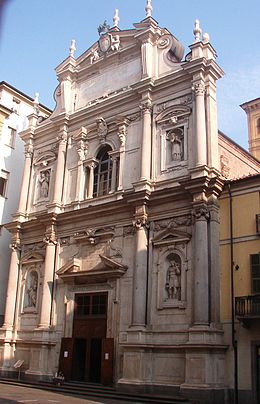
Molfetta is a town located in the northern side of the Metropolitan City of Bari, Apulia, southern Italy.

Amadeus IX, nicknamed the Happy, was the Duke of Savoy from 1465 to 1472. The Catholic Church venerates him with a liturgical feast on March 30.

Baroque architecture is a highly decorative and theatrical style which appeared in Italy in the early 17th century and gradually spread across Europe. It was originally introduced by the Catholic Church, particularly by the Jesuits, as a means to combat the Reformation and the Protestant church with a new architecture that inspired surprise and awe. It reached its peak in the High Baroque (1625–1675), when it was used in churches and palaces in Italy, Spain, Portugal and France, and Austria. In the Late Baroque period (1675–1750), it reached as far as Russia and the Spanish and Portuguese colonies in Latin America, Beginning in about 1730, an even more elaborately decorative variant called Rococo appeared and flourished in Central Europe.

Turin Cathedral is a Roman Catholic cathedral in Turin, northern Italy. Dedicated to Saint John the Baptist, it is the seat of the Archbishops of Turin.
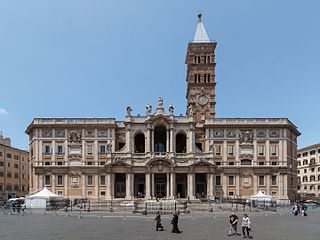
The Basilica of Saint Mary Major, or church of Santa Maria Maggiore, is a Papal major basilica and the largest Catholic Marian church in Rome, Italy.
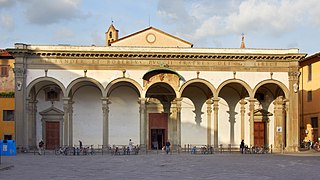
The Basilica della Santissima Annunziata is a Renaissance-style, Roman Catholic minor basilica in Florence, region of Tuscany, Italy. This is considered the mother church of the Servite Order. It is located at the northeastern side of the Piazza Santissima Annunziata near the city center.

Filippo Juvarra was an Italian architect, active in a late-Baroque style, who worked primarily in Italy, Spain, and Portugal.

Impruneta is a town and comune of the Metropolitan City of Florence in the Italian region of Tuscany. The population is about 15,000.

Genoa Cathedral is a Roman Catholic cathedral in the Italian city of Genoa. It is dedicated to Saint Lawrence, and is the seat of the Archbishop of Genoa. The cathedral was consecrated by Pope Gelasius II in 1118 and was built between the twelfth century and the fourteenth century as fundamentally a medieval building, with some later additions. Secondary naves and side covers are of Romanesque style and the main facade is Gothic from the early thirteenth century, while capitals and columns with interior corridors date from the early fourteenth century. The bell tower and dome were built in the sixteenth century.

The Basilica of Superga is a church in the vicinity of Turin.

The Royal Palace of Turin is a historic palace of the House of Savoy in the city of Turin in Northern Italy. It was originally built in the 16th century and was later modernized by Christine Marie of France (1606–1663) in the 17th century, with designs by the Baroque architect Filippo Juvarra. The palace also includes the Palazzo Chiablese and the Chapel of the Holy Shroud, the latter of which was built to house the famous Shroud of Turin. In 1946, the building became the property of the state and was turned into a museum. In 1997, it was placed on the UNESCO World Heritage Site list along with 13 other residences of the House of Savoy.
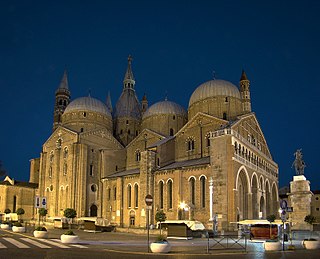
The Pontifical Basilica of Saint Anthony of Padua is a Roman Catholic church and minor basilica in Padua, Veneto, Northern Italy, dedicated to St. Anthony. Although the Basilica is visited as a place of pilgrimage by people from all over the world, it is not the titular cathedral of the city, a title belonging to the Cathedral-Basilica of St. Mary of Padua. The basilica is known locally as "il Santo". It is one of the eight international shrines recognized by the Holy See.

Gothic architecture appeared in the prosperous independent city-states of Italy in the 12th century, later than in Northern Europe. Each city developed its own particular variations of the style. Italian architects preferred to keep the traditional construction methods established in the previous centuries; architectural solutions and technical innovations of French Gothic were seldom used. Soaring height was less important than in Northern Europe. Brick rather than stone was the most common building material, and marble was widely used for decoration. In the 15th century, when the Gothic style dominated northern Europe and Italy, the north of the Italian Peninsula became the birthplace of Renaissance architecture.

The Palace of Venaria is a former royal residence and gardens located in Venaria Reale, near Turin in the Metropolitan City of Turin of the Piedmont region in northern Italy. With 80,000m² in palace area and over 950.000m² in premises, it is one the largest palaces in the world. It is one of the Residences of the Royal House of Savoy, included in the UNESCO Heritage List in 1997.

Turin is a city and an important business and cultural centre in northern Italy. It is the capital city of Piedmont and of the Metropolitan City of Turin, and was the first Italian capital from 1861 to 1865. The city is mainly on the western bank of the Po River, below its Susa Valley, and is surrounded by the western Alpine arch and Superga Hill. The population of the city proper is 849,795 while the population of the urban area is estimated by Eurostat to be 1.7 million inhabitants. The Turin metropolitan area is estimated by the OECD to have a population of 2.2 million.
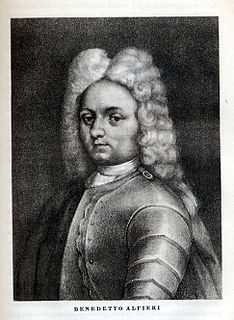
Benedetto Innocenzo Alfieri was an Italian architect, a representative of the late-Baroque or Rococo style.

The Santuario della Consolata or, in its full name, the Church of the Virgin of the Consolation is a prominent Marian sanctuary and minor basilica in central Turin, Piedmont, Italy. Colloquially, the sanctuary is known as La Consla. It is located on the intersection of Via Consolata and Via Carlo Ignazio Giulio.

San Filippo Neri is a late-Baroque style, Roman Catholic church located in Turin, region of Piedmont, Italy. The church is located on Via Maria Vittoria 5; the left flank of the nave faces the Turin Academy of Sciences. The church is still used for services. 69 metres (226 ft) long and 37 metres (121 ft) wide, it is the largest church in the city of Turin.

San Francesco da Paola is a Baroque style, Roman Catholic church located on Via di Po in Turin, region of Piedmont, Italy.

The Exilles Fort is a fortified complex in the Susa Valley, Metropolitan City of Turin, Piedmont, northern Italy. Together with the nearby Fort of Fenestrelle and the Forte Albertino it was part of the defensive line between the House of Savoy lands and France: both these states held it in different phases depending on the outcome of the various wars. It is located on a spur commanding one of the narrowest sections of the Susa Valley, along the main road connecting Turin to France.
